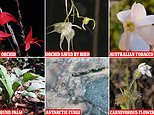
The scientists at Kew Gardens have revealed their top 10 plants and fungi discovered in 2023.
Last year, the Botanic Garden’s researchers named 74 new plants and 15 fungi, but these 10 discoveries are the strangest by far.
From an ‘explosive’ orchid from a dormant volcano to mysterious plants that flower underground, these discoveries show the amazing diversity of the natural world.
The scientists found new plants across all corners of the globe from the sweltering jungles of Borneo to the frozen wasteland of Antarctica.
However, time may already be running out for some of these plants, as the scientists believe that at least one is almost certainly already extinct in the wild.
From an ‘explosive’ orchid from a dormant volcano to mysterious plants that flower underground, Kew Gardens has revealed its top 10 plants and fungi discovered in 2023.
Kew Gardens’ top 10 new species of 2023 Aeranthes bigibbum – A rare orchid saved by a birdDendrobium lancilabium subspecies wuryae – An orchid found only on the peak of a dormant volcanoNicotiana Olens – A new species of Australian tobacco Crepidorhopalon droseroides – A potentially carnivorous flower Baphia arenicola – An underground treeLichtheimia koreana – A new species of pathogenic mouldArthonia olechiana – An Antarctic fungi that lives on lichen Pinanga subterranea – A palm that fruits and flowers underground Microchirita fuscifaucia – An extremely endangered violet Indigofera abbottii – An Indigo-bearing shrub named after a famous naturalist
In 2023, scientists from around the world discovered 2,500 new species of both plants and fungi.
But, despite steady progress, it is estimated that there are still 100,000 plants and up to 2.5 million fungi yet to be found.
Dr Martin Cheek, Senior Research Leader in Kew’s Africa Team, said: ‘It is imperative now, more so than ever, that we do everything in our power to go out into the field with our partners and work out which species of plants and fungi we haven’t given a scientific description yet.
‘Without doing so, we risk losing these species without ever even knowing they existed.’
1. An orchid saved by a rare bird
A new orchid species, Aeranthes bigibbum, was discovered on Madagascar by botanist Johans Hermans.
What makes this plant unique is that it is only found in a very small nature reserve managed by a group of villagers.
However, the reserve isn’t being maintained for the plant’s benefit.
Rather the villagers are tasked with protecting the extremely rare Helmet vanga, a bird with a stunning blue beak.
The money from visitors paying to see the bird provides the village with enough income to be able to protect the forest.
If it were not for the protection of the Helmet vanga, it is believed that the forest would have been lost and this beautiful flower along with it.
Researchers believe that this rare species of Orchid has only been saved due to an effort by locals to preserve the habitat of an endangered bird
2. An ‘explosive’ discovery on a dormant volcano
The expedition that found the brilliant red orchid, Dendrobium lancilabium subspecies wuryae, had not set out to find it.
The team who set out to the Indonesian Island of Waigeo had been attempting to discover a long-lost species of blue orchid which had not been seen for 80 years.
Not only were they successful but, on the summit of the the dormant volcano Mount Nok, they also found another previously unknown orchid.
This stunning scarlet bloom was named after Mrs Wury, the wife of Indonesia’s vice-president.
This brilliant red orchid thrives on the summit of Mount Nok, a dormant volcano on the Indonesian island of Waigeo
Scientists have found nine new species of tobacco growing in Australia in an attempt to understand how delicate plants like this can grow in such dry and harsh conditions
3. Nine species of Australian tobacco
Australia is home to some of the driest places on Earth, but even there researchers have found plant life blooming.
While plants in the Nicotiana family, which contains tobacco plants, are spread around the world, more than half of the 90 known species are found in Australia.
Kew Botanists Mark Chase and Maarten Christenhusz have spent years tracking down and studying the DNA of this family.
Their research helps scientists understand how these delicate and thin-leaved plants are able to survive in such harsh conditions.
In 2023, the scientists described a total of nine new species of Nicotiana, including N. olens, which they named after its pleasantly scented flowers.
4. A potentially carnivorous flower
A strange, sticky flower discovered in Madagascar last year has presented a mystery for botanists.
Found by field botanist Bart Wursten, this plant is covered with thin hairs each topped with a droplet of sticky dew.
Scientists are still not sure if this sticky Madagascan flower is an insect eating carnivore, even though it resembles other carnivorous plants it is actually in the same family as mint
It might seem strange for a plant to grow 90 per cent beneath the ground but in Angola this Baphia arenicola, which means ‘growing on sand’ does exaclty that
These hairs bear a striking resemblance to plants in the drosera or sundew family, a group of carnivorous plants that use their slimy secretions to trap and devour insects.
The similarity was so strong that scientists even named the plant Crepidorhopalon droseroides, which means ‘looks like a drosera’.
However, this strange flower is actually part of the family containing mint.
The researchers say that more observations and studies will be needed to see if this plant does actually eat insects.
5. A baffling pair of underground trees
It might seem strange that a species of plant could live underground, but in Angola, researchers have found two species of tree that do just that.
In the free-draining sands of the Kalahari, several plant families have evolved to be up to 90 per cent beneath the ground.
Baphia arenicola, which means ‘growing on sand’ and is part of the bean family, only pokes the very tips of its leaves and flowers above the ground.
This fungi was found growing on soy waste in South Korea and is in a family of fungi capable of causing human diseases, but scientists say it shouldn’t be too dangerous
The second species, which sports yellow flowers, was named Adjanys Cochlospermum after Adjany Costa winner of the 2019 UN Young Champions of the Earth Africa prize.
6. A new species of pathogenic fungus
After the hit TV show ‘The Last of Us’ got us all terrified of a fungal pandemic, this next discovery might not be the most welcome news.
The group of fungi called Lichtheimia contains six species that all appear across the globe in places where high temperatures can be found.
The fungi have been found in compost heaps, soil, food products, invertebrates, and even faeces.
However, out of the six species in this family, three are known to be human pathogens, meaning they can cause diseases in humans.
This new species, called Lichtheimia koreana, was discovered by Kew mycologist Dr. Paul Kirk hidden in soy waste in South Korea.
Very little is known about the fungi that grown on Antarctica’s lichens but researchers have now found three more of these extremely rare species
Luckily for us, Dr Kirk says that his discovery is not very closely related to its pathogenic cousins so is unlikely to be too dangerous to humans.
7. Three new Antarctic fungi
Looking at the barren waste of Antarctica, it might be easy to believe that this icy desert is completely devoid of life.
But although Antarctica has virtually no flowering plants, scientists have uncovered that the continent is home to hundreds of lichens.
Lichens, which are formed by a partnership between fungi, bacteria, and algae, survive on the bare rock that makes up only two per cent of Antarctica.
While more than 400 species of Antarctic lichens have been discovered little is known about the fungi that live and grow on them.
These new fungi make up three of the 100 species of fungi-living lichens now known to science.
8. An unusual underground palm
This unusual underground palm shocked the scientific community when it was discovered last year.
Named Pinanga subterranea, this is the first and only member of the palm family to fruit and flower entirely underground.
The Pinanga subterranea, shown here, shocked scientists when it was discovered as it is the only palm which grows both its fruit and flowers completely underground
This strange adaptation has so far only ever been observed in a single species of orchid.
However, while the discovery was new to science, local residents were not surprised in the slightest.
On the Islands of Borneo, where the palm was discovered, the plant and its bright red fruit are already well known to some local communities.
In fact, the plant already has multiple names in different Bornean languages.
The scientists who studied the plant say that this is proof that indigenous knowledge is a valuable tool for future research.
This species of violet is already considered extremely endangered as the only two sites it can be found are not protected
9. An endangered Thai violet
Of the 47 known species that make up the Microchirita family of plants, 37 live on Thailand’s limestone rocks.
This new species, which has small yellow flowers, is locally known as Yat neramit but has been named Microchirita fuscifaucia for the dark throat of the flower.
The rare flower is already considered threatened and is only known to live in two sites.
However, the plant’s future looks especially uncertain as both of these sites are unprotected by environmental legislation.
This latest discovery of an indigo bearing shrub from South Africa has been named Indigofera abbottii after Anthony Dixon Abbot
10. An indigo-bearing shrub
The members of the Indigofera family are known for the blue pigments they contain.
Dye from the 750 species of indigo-bearing plants known to science is used to die clothes from South America and the Caribbean to Indonesia.
Many Indigofera species found in Africa are either highly toxic or very palatable to livestock, but scientists still don’t understand which is which.
This latest discovery from South Africa has been named Indigofera abbottii after Anthony Dixon Abbot.
Anthony Abbot was a pioneering conservationist and amateur plant collector who found innumerable plant species including this very namesake
However, like many of the plants discovered this year, the Indigofera abbottii is already threatened by the clearance of its habitat for agriculture.
Source link
CHECK OUT: Top Travel Destinations
READ MORE: Travel News



